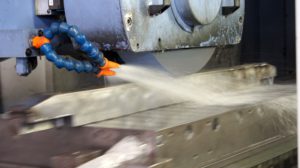
Cortec Corporation, a global leader in Vapor phase Corrosion Inhibitor technology, holds a strong belief in the importance of integrating corrosion protection solutions directly into a manufacturer’s process. Powered metallurgy, a steadily growing sector of the metalworking industry with a strong pull from the automotive industry, is an excellent example of how corrosion inhibitors can be incorporated right into the process for improved efficiency and diminished rust claims. This builds customer trust and ultimately lowers overall costs.
It Starts with Raw Materials
Corrosion can start before the metal powder even leaves the barrel. Moisture festering inside the drum can leave rust spots in the powder, presenting an unwelcome surprise when the drum is opened. Desiccant is used to absorb the moisture, but as it does so, the saturated desiccant may begin to cause corrosion itself. An excellent alternative is the use of pouches filled with Cortec’s Vapor phase Corrosion Inhibitors (VpCIs). VpCI molecules vaporize from a source material, such as a powder-filled pouch or impregnated foam pad, and diffuse until they evenly fill an enclosed space with their protective vapor. This vapor condenses on metal surfaces and forms a monomolecular protective layer against corrosive elements such as oxygen and moisture. When, in the case of the metal powder, the drum is opened, the VpCI molecules will disperse, leaving the powdered metal ready to use and corrosion free. VpCIs can be used by themselves or in conjunction with desiccants to combine moisture-absorption with corrosion inhibiting properties.
Preventing Rust During In-Process Storage
Storage of in-process parts is a critical time for corrosion protection, especially because freshly machined parts are susceptible to flash rust. After powdered metals are compacted and sintered into shape, the new parts often must sit in storage for a day or a week until the next step of the process. Interim storage is often repeated throughout the powdered metallurgy process and can again be addressed with simple VpCI treatments. Options include dipping parts into Cortec’s liquid rust preventives or simply wrapping and placing in bins lined with VpCI paper, film, or bags. When these packages are closed, the VpCIs from the paper or film disperse throughout the enclosure to form a new protective layer on the metal parts. Once the packaging is opened, the VpCIs disperse, and the parts can be immediately put back into process without any cleaning or degreasing required.
Rust Preventive Machine Lubricants
Partially formed parts go on to further machining—such as cutting, drilling, or turning—for greater precision. This is often done in a CNC machine. At this point, coolants and lubricants are critically needed to protect tools and machining surface from high metalworking temperatures. VpCI lubricant additives can be incorporated directly into these fluids for additional protection against flash rust. Further interim storage typically follows.
Protection During Abrasive Blasting
Steel shot, ceramics, or other tough particles are often used as abrasive blast material to smooth and polish the surface of machined powdered metal parts. This is a potential corrosion problem not only for the freshly polished surfaces, but also for the steel shot frequently used as an abrasive. Adding a VpCI powder to the shot is an excellent way to prevent rust on both the shot and machined parts by including corrosion protection directly in the vulnerable process.
Cleaning and Corrosion Protection in One Step
Cleaning is another common step employed throughout the powdered metal process. However, any time moisture is introduced into the metallurgy process, it raises additional corrosion risk for the newly machined parts. Rather than using a two-step process to clean and apply a corrosion inhibitor, Cortec offers many washes that incorporate corrosion inhibitors into the cleaning fluid to streamline the process.
Ensuring Safe Delivery to the Customer
Once the final product has been made, it is critical to preserve it in corrosion-free condition until it arrives safely to the customer. Preservation methods similar to those used for earlier interim storage are very simple but very effective and eliminate extra degreasing steps. Versatile options allow powdered metal manufacturers to select VpCI linerboards, papers, emitters, pouches, foam pads, or gusseted VpCI bags to protect the finished goods during shipment. When the products arrive at the customer corrosion free, it not only saves the company money, but also fosters an invaluable relationship of trust.
Special thanks to Stephen Pearl, Cortec Regional Sales Manager, for his insight into VpCI applications for powdered metallurgy.




I find this article interesting in that Powdered Metal is a relatively new technology. However, do my customers really have a problem in the powdered state? If so to what degree? And in what part of the manufacturing process? Further, which VpCI product do i use? One of my customers uses 126 bags in shipping. I need more info on questions to ask before that point in the manufacturing process. What can you give me to increase my base of knowledge?